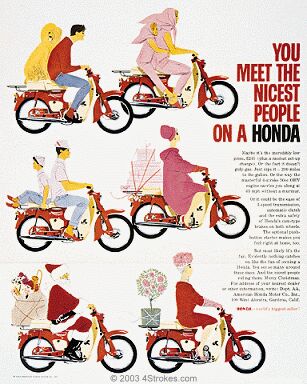Motorcycle Advertising Part One - Motorcycle.com
If you are anything like me, you enjoy motorcycle advertising almost as much as watching a TV show or reading a magazine story about motorcycles. In fact, some magazine editors will tell you that a really good motorcycle ad campaign can generate as much reader interest and feedback as a good editorial or bike review.
That’s one of the reasons you see so many ads in motorcycling magazines. And the other is that motorcycle manufacturers long ago learned that “enthusiast press” (read: motorcycle magazines) is far and away the best way to reach and influence their target market. Unfortunately, TV ads for motorcycles are relatively scarce, especially when it comes to mainstream programming, simply because we motorcyclists make up such a small percentage of TV viewers. Thank goodness for cable TV or you would almost never see any motorcycle ads on TV.
Still, there have been some great ad campaigns mounted by the motorcycle manufacturers over the years, even if most of them never got the kind of exposure you or I might think they deserved. Undoubtedly, the most famous and most successful of all time was the “You Meet the Nicest People on a Honda” campaign, mounted by Grey Advertising for Honda in 1962.
"By 1964, various forms of the “Nicest People” ads had made a major impact on American society..."
The ads depicted housewives, a parent and child, young couples and other respectable members of society, riding Honda 50s for a variety of purposes. To many who would have previously rolled their eyes at the very mention of the word “motorcycle,” it legitimized the little Hondas as a means of casual and convenient transportation.
By 1964, various forms of the “Nicest People” ads had made a major impact on American society, and were credited with actually winning recognition for the motorcycle as a socially acceptable product. For the first time in history, motorcycles, especially the little 50cc Hondas, even became a hot-selling Christmas gift. The “Nicest People” ads were produced in dozens of different versions over the next 10 years, making it one of the longest-running “theme” ad campaigns in motorcycling history. (See rest of Honda photos.
Also in 1964, riding high on the success of the print ad campaigns, Honda decided to roll the dice again, spending $300,000 to become a sponsor for that year’s Academy Awards broadcast. Remember, that was $300,000 in 1964 currency, and at the time represented an investment equal to approximately $11 for every single Honda motorcycle sold in the entire world during the previous year. If you applied the same formula today, that would be an investment of more than $40,000,000 (that’s 40 million dollars!). The program was seen by 80% of all TV viewers in the U.S., and up until that time had never been sponsored by a foreign company, let alone a motorcycle manufacturer. Industry insiders saw it as the greatest advertising gamble ever attempted, and predicted it would either make or break Honda as a force in the U.S. marketplace.
"Annual sales of Honda motorcycles jumped from 40,000 units a year to a staggering 200,000 units per year..."
Of course, we all know what happened. Within weeks of the broadcast, Honda was overwhelmed with requests to start up new dealerships and inundated with offers from other large corporations wanting to tie their own ad campaigns in with Honda. Annual sales of Honda motorcycles jumped from 40,000 units a year to a staggering 200,000 units per year, a 500% sales increase. No wonder that to this day, in colleges and universities around the world, the “Nicest People” campaign is studied as a model for a successful advertising campaign.
The almost-unbelievable success of Honda’s campaign had several far-reaching effects on the U.S. motorcycle market. For one thing, almost overnight the virtual stranglehold that British bike manufacturers had enjoyed in this country was shaken loose. Predominant brands like Triumph and BSA suddenly woke up one day to find themselves playing second fiddle to the upstart from Japan, and they weren’t at all pleased about it. For another, several other Japanese bike manufacturers saw Honda’s success as a springboard for mounting their own invasions of the highly-lucrative American market. And, finally, even Harley-Davidson got into the act.
What I find most interesting is that these other manufacturers divided up, basically, into two separate camps: Those who tried to emulate Honda’s “Nicest People” approach as closely as possible, and those who tried to distance themselves from it. And then there was a third group, which tried to have it both ways.
First, let’s look at the copycats: Yamaha, Vespa and, believe it or not, Harley-Davidson. Yes, Milwaukee was suffering through the doldrums of the AMF period in the early Sixties and saw Honda’s success in the small-bore motorcycle market as their ticket to success. Almost immediately, H-D came out with an ad campaign called “Young America” that looked suspiciously similar to Honda’s “Nicest People” campaign.
More by Fred Rau
































Comments
Join the conversation